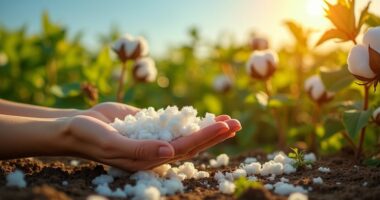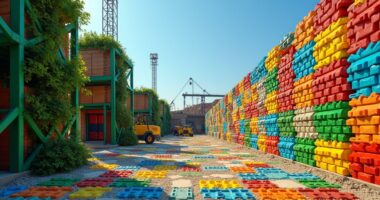The fiber market is buzzing with excitement, transforming thanks to next-gen materials and sustainable innovations. High-performance fibers are predicted to soar from $18.7 billion in 2025 to nearly $40 billion by 2035, fueled by a 7.8% growth rate. Meanwhile, ingenious creations like mushroom-based Mylo and pineapple Piñatex are redefining what textiles can be. With brands racing towards eco-friendly practices, the future is bright for materials that can give Mother Nature a run for her money. Stay tuned for more surprising details!
Quick Overview
- The high-performance fiber market is projected to grow significantly, reaching USD 39.9B by 2035 with a CAGR of 7.8%.
- Innovations like Mylo and Piñatex are transforming material sourcing by utilizing agricultural waste and providing sustainable alternatives to leather.
- The global textile fiber market is shifting towards eco-friendly options, with a projected value of USD 70.8B by 2034.
- Smart textiles incorporating AI and IoT are enhancing functionality, offering adaptive solutions for various industries including aerospace and automotive.
- Sustainability is a key focus, with brands aiming for 100% recycled polyester by 2025 and a projected sustainable fiber market of $2.9B.
Market Trends and Growth Projections
In the ever-evolving world of materials, the fiber market is gearing up for a growth spurt that rivals a teenager at a buffet.
The high-performance fiber market is projected to soar from USD 18.7B in 2025 to USD 39.9B by 2035, fueled by demand in aerospace and automotive applications. The market is expected to expand around 2.1X through 2035 with a projected CAGR of 7.8%. Additionally, the market is projected to reach USD 35.48 billion by 2034, highlighting the significant potential for growth and innovation in this sector.
Meanwhile, the global textile fiber market is expected to grow from USD 48.3B in 2024 to USD 70.8B by 2034. Manufacturers are increasingly incorporating sustainable textiles into their product lines to meet growing consumer demand for eco-friendly options.
With Asia Pacific leading the charge and innovations driving change, the landscape is set for a dynamic transformation.
It’s a thrilling time to be in the fiber business!
Technological Innovations and Application Shifts
The fiber market is experiencing a technological renaissance, where innovation is driving a whirlwind of changes across various industries.
The fiber market is buzzing with innovation, sparking transformative changes across diverse industries.
Innovations like mushroom-based Mylo and pineapple-derived Piñatex are turning agricultural waste into trendy leather alternatives. Meanwhile, Circulose® aims to recycle enough materials for 1.4 billion T-shirts by 2030, highlighting the potential of bio-based and recycled materials. Advanced composites are lightening the load for electric vehicles, while smart textiles flaunt self-sensing yarns and adaptive fabrics that keep wearers comfy. As new materials enhance efficiency and performance, they pave the way for even more groundbreaking applications in the fiber sector.
Proper waste management practices are essential for maximizing the environmental benefits these eco-friendly materials offer throughout their lifecycle.
As textiles merge with AI and IoT, they’re becoming the brains of smart clothing. Fiber’s future? It’s looking brighter than a neon sign at a tech convention!
Sustainability Initiatives and Regional Dynamics
A whirlwind of innovation might be reshaping the fiber market, but sustainability initiatives are taking center stage, proving that eco-friendliness can be just as trendy as the latest fashion.
With over 58% of brands aiming for 100% recycled polyester by 2025, the shift is palpable. The 2025 Recycled Polyester Challenge aims to increase the market share of recycled polyester from 14% in 2019 to 45% by 2025.
No longer just a niche, the sustainable fiber textiles market is projected to reach nearly $2.9 billion by 2025. Additionally, sustainable fiber solutions are being developed through global partnerships between universities and industry leaders, ensuring innovative advancements in the fiber sector.
Consumers are increasingly adopting circular fashion practices that extend the lifecycle of garments through reuse, repair, and recycling, significantly reducing textile waste.
As Asia leads in eco-friendly fiber manufacturing, North America champions hemp, and Europe invests in bio-based alternatives, regional dynamics are propelling the fiber industry towards a greener future, ensuring that even textiles can be eco-chic.









